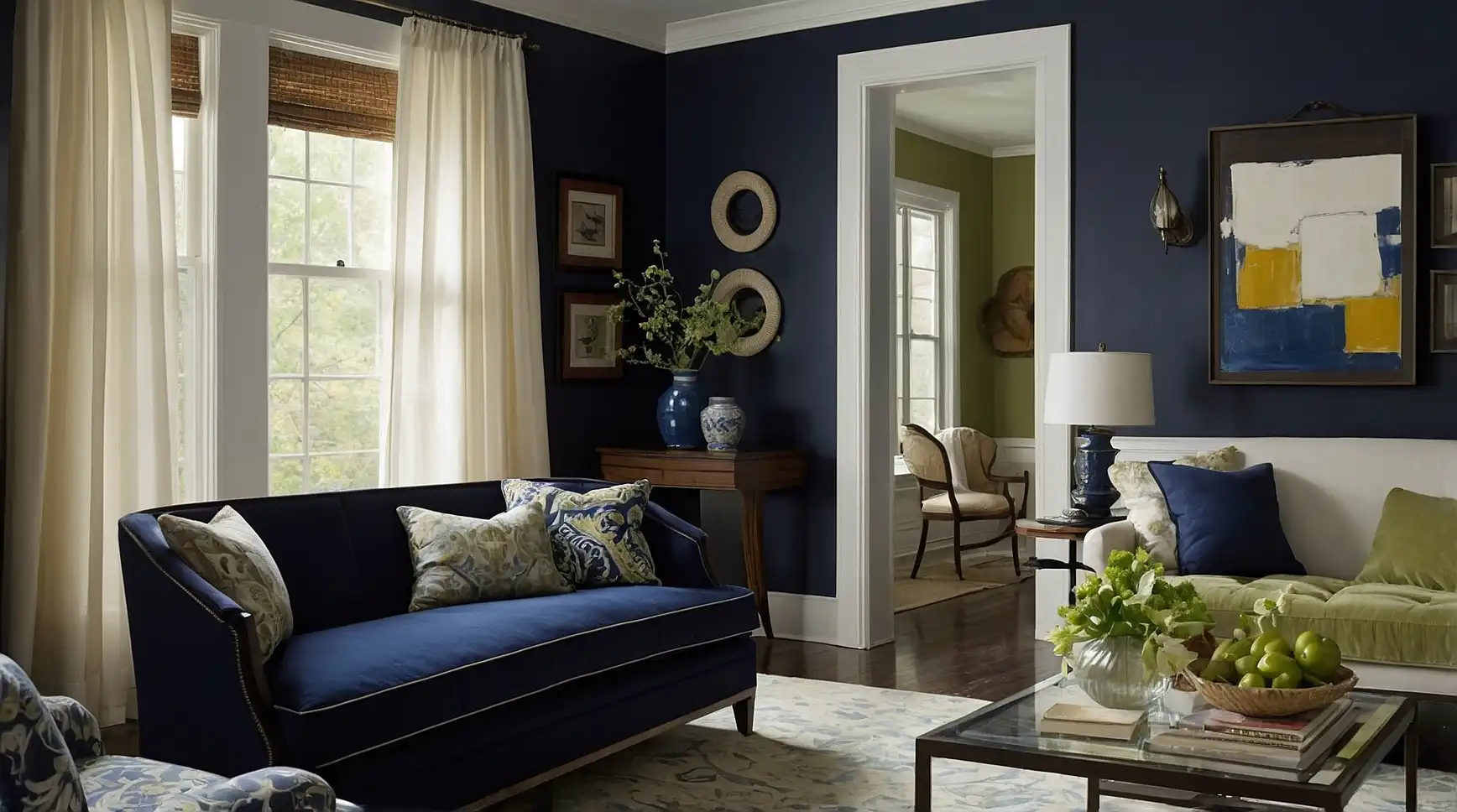27 Transformative Paint Colors That Brighten Even the Darkest Rooms
Dealing with a dark room can feel like an interior design challenge.
Whether you’re battling limited natural light, north-facing windows, or a basement space, choosing the right paint color makes all the difference in how bright and inviting your room feels.
The good news?
You don’t need to settle for stark white walls. Today’s paint technology offers numerous options that reflect and maximize available light while adding personality to your space.
Let’s explore 27 designer-recommended paint colors that will transform your dark room into a brighter, more welcoming environment without sacrificing style or character.
1: Pale Butter Yellow

Pale butter yellow mimics sunshine, instantly brightening dark rooms with its warm, golden glow. This cheerful hue reflects available light remarkably well.
Choose a butter yellow with beige undertones rather than neon brightness for sophisticated warmth.
Benjamin Moore’s “Hawthorne Yellow” or Sherwin Williams’ “Butter Up” offer perfect options.
This color performs especially well in north-facing rooms that lack natural warmth in their light quality.
2: Soft Silvery Gray

Soft silvery gray creates an airy, reflective backdrop that maximizes limited light in dark rooms. This versatile neutral adds sophistication without the starkness of pure white.
Select a silver with cool blue undertones rather than brown or purple for maximum light reflection.
Benjamin Moore’s “Gray Owl” or Sherwin Williams’ “Misty” deliver perfect brightness.
This color shifts beautifully throughout the day, maintaining luminosity even as light conditions change.
3: Pale Lavender

Pale lavender introduces gentle color while brightening dark rooms with its light-reflective properties. This unexpected hue creates a sophisticated, dreamy atmosphere.
Choose a lavender with significant gray undertones rather than saturated purple. Benjamin Moore’s “Hint of Violet” or Sherwin Williams’ “Dreamy” offer refined options.
This color appears almost silver in certain lights while maintaining subtle color dimension that flat neutrals lack.
4: Warm Peach

Warm peach reflects light beautifully while adding welcoming coziness to dark rooms. This subtle orange-pink hybrid creates a flattering, glowing environment.
Select a peach with beige undertones rather than neon brightness for sophisticated warmth. Benjamin Moore’s “White Blush” or Sherwin Williams’ “Naive Peach” offer refined options.
This color performs especially well in rooms that feel cold or unwelcoming due to limited natural light.
5: Pale Aqua

Pale aqua brightens dark rooms with its reflective quality while adding subtle freshness. This light blue-green hybrid creates a spa-like tranquility.
Choose an aqua with significant white undertones rather than saturated turquoise. Benjamin Moore’s “Morning Sky Blue” or Sherwin Williams’ “Tidewater” offer perfect options.
This color’s water association adds psychological brightness to spaces lacking natural light.
6: Creamy Off-White

Creamy off-white offers more warmth than stark white while maintaining excellent light-reflecting properties. This versatile neutral brightens dark spaces without feeling clinical.
Select a cream with yellow or ivory undertones rather than pink or gray. Benjamin Moore’s “Swiss Coffee” or Sherwin Williams’ “Creamy” create the perfect balance.
This color works exceptionally well with warm-toned furnishings and wood elements in light-challenged spaces.
7: Soft Coral

Soft coral injects cheerful warmth while brightening dark rooms through excellent light reflection. This happy hue creates an instantly welcoming environment.
Choose a coral with significant beige undertones rather than neon brightness. Benjamin Moore’s “Coral Essence” or Sherwin Williams’ “Coral Clay” offer sophisticated options.
This color brings natural warmth to north-facing rooms that tend to feel cold and shadowy.
8: Pale Mint Green

Pale mint green reflects light beautifully while adding refreshing color to dark rooms. This gentle hue creates a bright, airy feeling even in basement spaces.
Select a mint with significant white undertones rather than saturated green. Benjamin Moore’s “Fresh Mint” or Sherwin Williams’ “Mint Condition” offer perfect options.
This color’s association with freshness counteracts the psychological heaviness of dark spaces.
9: Light Apricot

Light apricot brightens dark rooms with its warm, sunlit quality that mimics natural light. This golden-peachy hue creates an inviting, glowing environment.
Choose an apricot with yellow undertones rather than pink for maximum brightness.
Benjamin Moore’s “Georgian Peach” or Sherwin Williams’ “Inventive Orange” offer perfect options.
This color performs magic in rooms with northern or eastern exposure that lack warm afternoon light.
10: Pearl Gray

Pearl gray brightens dark rooms with its subtle reflective quality while adding sophisticated depth. This luminous neutral offers more interest than plain white.
Select a pearl gray with slight blue or green undertones rather than purple or brown.
Benjamin Moore’s “Moonshine” or Sherwin Williams’ “Silverplate” create perfect brightness.
This color shifts beautifully throughout the day, maintaining its light-enhancing properties even in evening hours.
11: Buttercream

Buttercream offers rich warmth while brightening dark rooms through excellent light reflection. This buttery off-white creates a welcoming, sunlit feeling.
Choose a buttercream with gold undertones rather than green for maximum warmth. Benjamin Moore’s “Philadelphia Cream” or Sherwin Williams’ “Cachet Cream” offer perfect options.
This color instantly counteracts the cave-like feeling that dark rooms often project.
12: Pale Blush Pink

Pale blush pink brightens dark rooms with its reflective quality while creating a flattering, rosy glow. This subtle pink functions almost as a neutral.
Select a blush with beige undertones rather than purple for sophisticated warmth. Benjamin Moore’s “Pink Bliss” or Sherwin Williams’ “Intimate White” offer refined options.
This color adds gentle warmth to spaces that feel cold or unwelcoming due to limited natural light.
13: Light Dove Gray

Light dove gray brightens dark rooms with its reflective quality while adding sophisticated depth. This airy neutral offers more dimension than stark white.
Choose a dove gray with warm undertones rather than cool blue for a welcoming feel. Benjamin Moore’s “Classic Gray” or Sherwin Williams’ “Incredible White” create perfect balance.
This color creates a bright, expansive feeling even in the most challenging light conditions.
14: Soft Wheat

Soft wheat reflects light beautifully while adding natural warmth to dark rooms. This golden neutral creates a welcoming, sunlit environment.
Select a wheat with yellow undertones rather than orange for sophisticated brightness. Benjamin Moore’s “Monroe Bisque” or Sherwin Williams’ “Ivoire” offer perfect options.
This color performs especially well in basement spaces that lack any natural light source.
15: Pale Pistachio

Pale pistachio brightens dark rooms with its reflective quality while adding subtle freshness. This yellow-green hybrid creates unexpected cheerfulness.
Choose a pistachio with significant white undertones rather than saturated green. Benjamin Moore’s “Spring Meadow” or Sherwin Williams’ “Lighter Mint” offer sophisticated options.
This color’s natural association adds vibrant energy to spaces lacking brightness.
16: Soft Sky Blue

Soft sky blue reflects light beautifully while visually expanding dark rooms. This airy hue creates a bright, open feeling even in challenging spaces.
Select a sky blue with gray undertones rather than periwinkle for maximum light reflection.
Benjamin Moore’s “Breath of Fresh Air” or Sherwin Williams’ “Wondrous Blue” offer perfect options.
This color’s association with open skies counteracts the psychological confinement of dark rooms.
17: Light Sand

Light sand brightens dark rooms with its warm reflective quality while maintaining versatile neutrality. This sophisticated beige creates a naturally luminous backdrop.
Choose a sand with yellow undertones rather than gray for maximum warmth.
Benjamin Moore’s “Mannequin Cream” or Sherwin Williams’ “Steamed Milk” offer perfect options.
This color’s connection to beaches and sunshine adds psychological brightness to challenging spaces.
18: Pale Celadon

Pale celadon reflects light beautifully while adding subtle sophistication to dark rooms. This historical blue-green hybrid creates unexpected brightness.
Select a celadon with significant white undertones rather than saturated green.
Benjamin Moore’s “Palladian Blue” or Sherwin Williams’ “Breaktime” offer refined options.
This color performs especially well in traditional homes where stark whites might feel out of place.
19: Warm Alabaster

Warm alabaster brightens dark rooms with its reflective quality while offering more dimension than plain white. This creamy neutral creates a sophisticated, luminous environment.
Choose an alabaster with yellow undertones rather than pink or gray. Benjamin Moore’s “White Dove” or Sherwin Williams’ “Alabaster” create perfect brightness.
This color works beautifully with both traditional and contemporary furnishings in light-challenged spaces.
20: Pale Straw

Pale straw reflects light exceptionally well while adding gentle warmth to dark rooms. This subtle yellow creates a sunlit feeling even in basement spaces.
Select a straw with beige undertones rather than green for sophisticated brightness. Benjamin Moore’s “Windham Cream” or Sherwin Williams’ “Erstwhile” offer perfect options.
This color counteracts the gray, shadowy feeling that dark rooms often project.
21: Soft Pearl White

Soft pearl white brightens dark rooms with its subtle iridescence that maximizes limited light. This dimensional white adds sophisticated luminosity.
Choose a pearl with warm undertones rather than cool blue for a welcoming feel. Benjamin Moore’s “White Diamond” or Sherwin Williams’ “Pearly White” create perfect brightness.
This color reflects and enhances both natural and artificial light sources beautifully.
22: Light Seafoam

Light seafoam reflects light beautifully while adding refreshing color to dark rooms. This pale blue-green hybrid creates a bright, airy atmosphere.
Select a seafoam with significant white undertones rather than saturated aqua. Benjamin Moore’s “Ocean Air” or Sherwin Williams’ “Sea Salt” offer sophisticated options.
This color’s association with open water and horizons visually expands confined, dark spaces.
23: Warm Bisque

Warm bisque brightens dark rooms with its golden reflective quality while maintaining versatile neutrality. This sophisticated cream creates a naturally luminous environment.
Choose a bisque with yellow undertones rather than pink for maximum warmth.
Benjamin Moore’s “Acadia White” or Sherwin Williams’ “Divine White” offer perfect options.
This color performs especially well in rooms that need to feel both bright and cozy simultaneously.
24: Pale Celery

Pale celery reflects light exceptionally well while adding subtle freshness to dark rooms. This yellow-green hybrid creates unexpected brightness.
Select a celery with significant white undertones rather than saturated chartreuse.
Benjamin Moore’s “Sweet Celery” or Sherwin Williams’ “Meringue” offer refined options.
This color’s natural association adds vibrant energy to spaces lacking brightness.
25: Soft Magnolia

Soft magnolia brightens dark rooms with its warm reflective quality while offering more dimension than plain white.
This creamy floral white creates sophisticated luminosity.
Choose a magnolia with yellow undertones rather than pink for maximum brightness.
Benjamin Moore’s “China White” or Sherwin Williams’ “Magnolia” create perfect warmth.
This color works beautifully in traditional settings where stark whites might feel uncomfortable.
26: Pale Linen

Pale linen reflects light beautifully while adding natural texture to dark rooms. This sophisticated off-white creates a bright yet organic environment.
Select a linen with warm undertones rather than cool gray for a welcoming feel.
Benjamin Moore’s “Linen White” or Sherwin Williams’ “Natural Linen” offer perfect options.
This color’s association with natural fabrics adds subtle dimension that flat whites lack.
27: Light Silvery Blue

Light silvery blue brightens dark rooms with its reflective quality while adding subtle sophistication.
This luminous cool tone creates an expansive feeling.
Choose a silvery blue with gray undertones rather than periwinkle for maximum light reflection.
Benjamin Moore’s “Silver Mist” or Sherwin Williams’ “Misty” offer refined options.
This color performs especially well in south-facing rooms that tend to feel overly warm or yellow.
Conclusion
The right paint color transforms a dark, gloomy room into a bright, welcoming space.
By choosing shades specifically designed to maximize light reflection, you’ll create a luminous environment regardless of your room’s natural lighting challenges.







